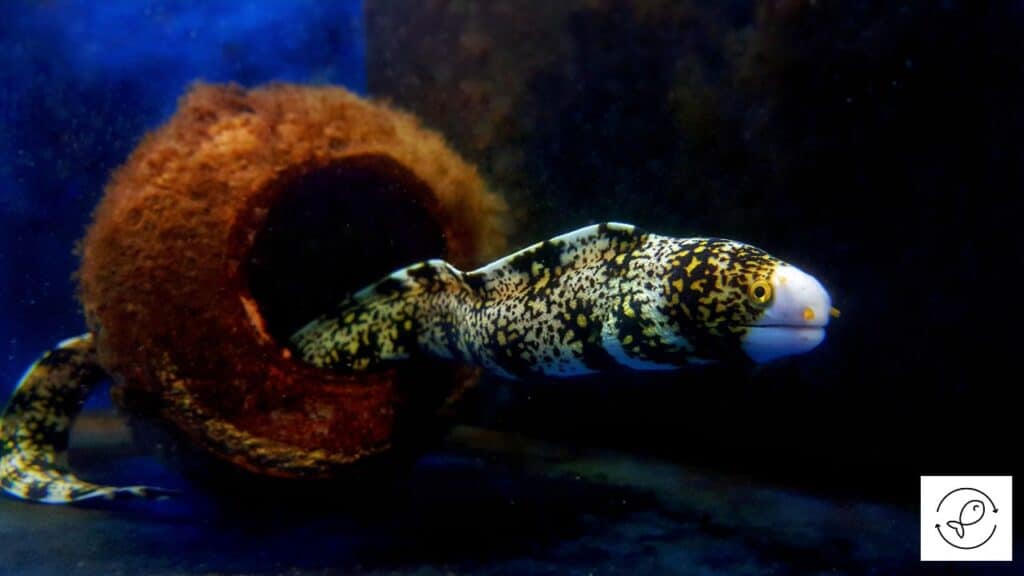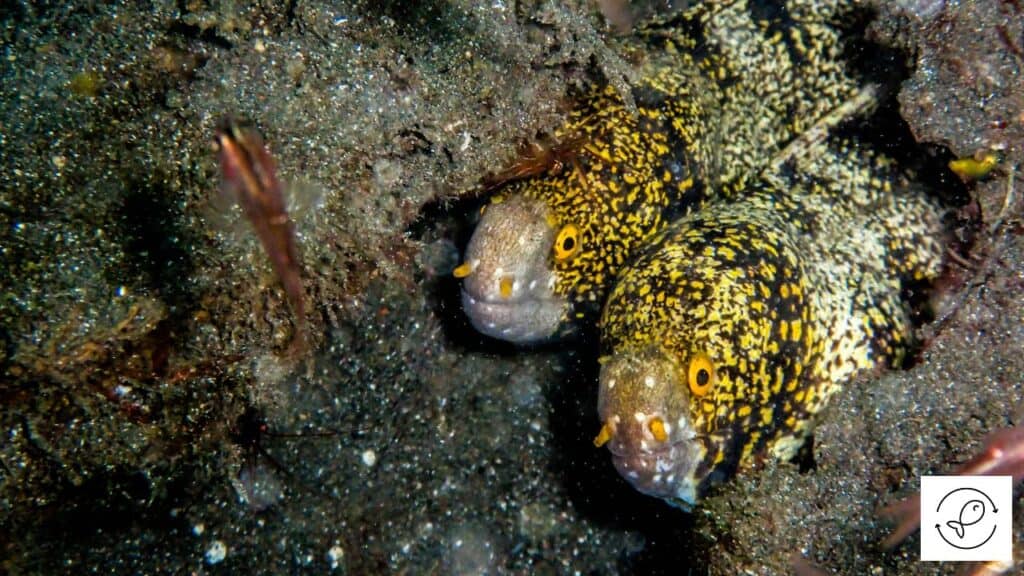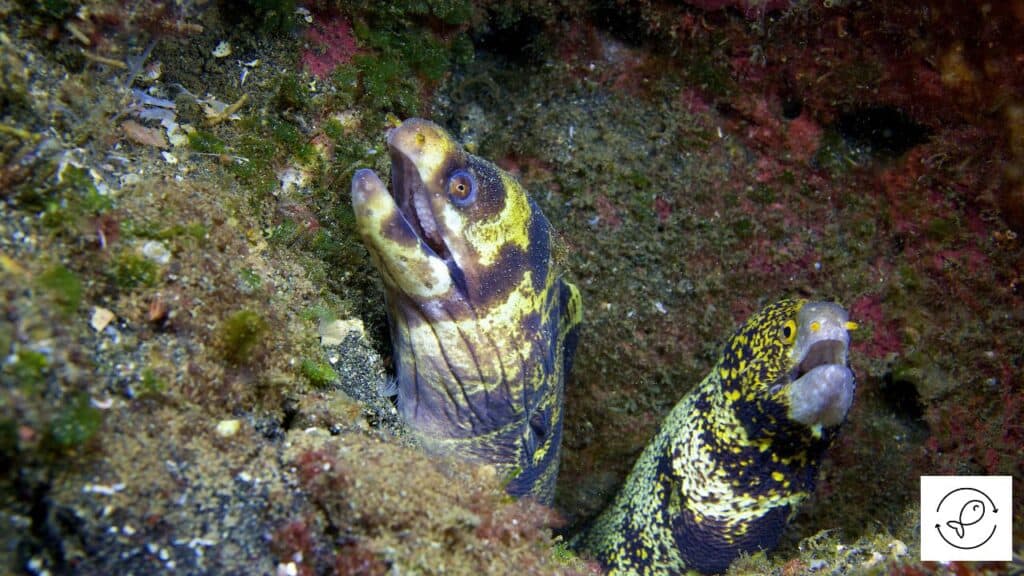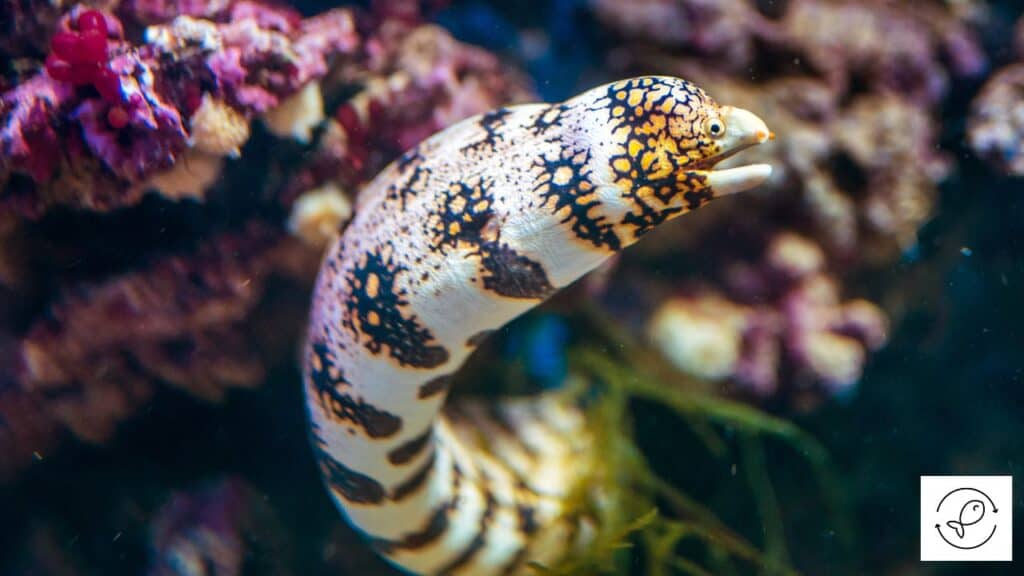Snowflake eels are a great addition to any marine aquarium due to their beautiful coloration and unique behavior.
They’re one of the most adaptable saltwater eel species and favorites among novice and experienced aquarists alike.
So let’s see how to take care of them and other important details about these eels.
Snowflake Eels – Species Overview
Snowflake eels are also popularly known as snowflake moray, clouded moray eel, starry eel, floral eel, white and zebra moral eel, and nebulous moray eel.
These eels are a species of marine eels belonging to the Muraenidae family.
They’re widespread throughout the Indo-Pacific ocean reefs.
Snowflake eels also inhabit the tropical waters of the Red Sea and Africa, the western coast of the United States, Central America, Mexico, and Hawaii.
They live in caves, rock crevices, seagrass beds, intertidal reef flats, and tidal pools in their natural habitat.
Appearance

Snowflake eels have a cylindrical body resembling that of a snake.
Their long body is graced with ornamental patterns on their sides.
The color of these eels is either cream or white with speckled bands of black blotches with yellow spotting.
Snowflake eels have a yellow ring around their eyes with yellow markings on their head.
They also have strong teeth that help them crush invertebrate exoskeletons easily while hunting in the wild.
These eels are protogynous, meaning they can change gender during their lifetime.
The dominant snowflake eel among the group usually changes from female to male.
Gender change can take several months and is more common in their natural environment.
Lifespan
The average lifespan of snowflake eels is 4 years or more. However, they have been known to live for around 15 years in captivity.
It mainly depends upon the care they’re given and the conditions in which they’re kept.
Snowflake eels are a very hardy species and are disease resistant.
Hence, a conducive living environment and a well-balanced diet can help them live long and healthy life.
Average Size
Snowflake eels are one of the large marine species. In the wild, these eels can grow up to 39 inches in length.
In captivity, snowflake eels generally don’t grow that large. They reach a maximum length of 24 inches in home aquariums.
Snowflake Eel Tank Setup

Snowflake eels are reef-safe and don’t need a specialized tank setup.
A large tank with ample hiding places and stable water parameters is sufficient for them to thrive.
Setting up a reef-like environment that closely replicates their natural habitat can make them feel at home.
Tank Size
Snowflake eels do best when housed in a large aquarium with ample space to swim freely and explore the surrounding.
A tank of at least 75 gallons is recommended for a single snowflake eel.
They need a setup that replicates their natural reef environment.
Snowflake eels grow pretty large, up to 2 feet in captivity. Besides, they grow very fast if fed a nutritious diet.
Hence, they can quickly outgrow a small tank.
Housing snowflake eels in a small tank can restrict their growth and cause stress, leading to aggressive behavior.
Tank Equipment and Decorations
Snowflake eels are bottom dwellers. Hence, it’s crucial to provide a substrate that will allow them to burrow and rest.
These eels are usually shy till they get accustomed to the tank conditions.
So they need ample hiding places, such as caves, crevices, holes, etc., to feel secure.
You can equip their tank with at least one cave. If you have a large tank, 3 to 4 suitable-sized caves are recommended.
The caves need to be placed in such a manner that your snowflake eel can move from one end of the tank to the other without being exposed to other tankmates.
These eels are reef dwellers. Hence, live rocks can be added to the tank to mimic the look of coral reefs.
Besides providing adequate hiding spaces, you can also have plants and other decorations to keep your snowflake eel entertained.
Since snowflake eels are popular for escaping the tank, a tightly sealed lid is a must.
Given below are the items required in a snowflake eel tank:
- Suitable substrate,
- Aquarium lid or hood,
- Filter,
- Heater,
- Aquarium lighting,
- Aquatic plants,
- Hiding places like live rocks, caves, driftwood, etc.
- Thermometer, and
- PH testing kit.
Snowflake Eel Care

Snowflake eels are known for adapting to aquarium conditions pretty well.
Hence, they’re favorites among aquarists while setting up a marine aquarium.
Although hardy, snowflake eels need adequate attention and care for optimum growth.
Diet
Snowflake eels are carnivores. In the wild, these eels primarily feed on small fish and crustaceans.
Hence, feeding a protein-rich diet is essential for them to thrive in captivity.
You can feed snowflake eels a varied diet consisting of live and frozen krill, clams, octopus, squid, calamari, crabs, mussels, lobster, shrimp meat, scallops, and other meaty foods enriched in vitamins.
You can feed live ghost shrimp till the time they get acclimated to consuming frozen foods.
Unlike other marine aquarium fish that need daily feeding, these eels are an exception.
Snowflake eels can be fed several times a week. Daily feeding isn’t required.
You can feed them on alternate days for better digestion. Feeding 3 to 4 times a week is ideal for them.
Snowflake eels can even go on hunger strike occasionally and may refuse to eat for a week.
But you need to be ready with food every day.
Once hungry, snowflake eels may try to hunt tankmates if food isn’t available in the tank.
Snowflake eels are also known to bite the hands of owners while feeding. Hence, it’s better to avoid hand feeding.
Instead, you can sprinkle the food near them in the tank using a long tong and leave it up to them to eat it.
Water Parameters
Snowflake eels adapt well to a wide range of water conditions. However, stable water parameters can help them thrive.
Being tropical marine fish, they need warm water temperatures.
The ideal water parameters for snowflake eels are:
Water Temperature: 72°F to 80°F (22°C to 27°C),
Water pH: 8.1 to 8.4,
Specific Gravity (Salinity): 1.020 to 1.025,
Water Hardness (dGH): 8 to 12.
Tank Maintenance
Snowflake eels are messy eaters. Hence, tank maintenance should be your first priority.
Regular water changes are necessary to keep the water clean and free from impurities.
You also need to clean the substrate and other decorative items periodically.
The heater, filter, and other equipment must be checked regularly to ensure they’re working at full capacity.
Similarly, water parameters need to be monitored periodically with a test kit.
Common Diseases
Snowflake eels are generally hardy and kind of resistant to diseases. However, they aren’t immune to diseases.
Snowflake eels don’t have a thick outer covering of scales, unlike most other aquarium species.
This makes them susceptible to infections if the tank conditions aren’t maintained.
Their skin is also exposed to tank water because they don’t have protective scales.
Hence, you must avoid treating tank water with chemicals and medications that can harm them.
Given below are some of the common diseases that may affect snowflake eels:
- Bacterial and fungal infections,
- Marine Ich,
- Liver disease by eating freshwater feeder fish like goldfish, rosy reds, etc.
Snowflake Eel Behavior and Temperament
Snowflake eels are mostly shy when placed in a new aquarium.
They can be seen hiding under rocks or crevices most of the time.
However, they start exploring their environment once they get used to it.
They’re more active during the night as they search for food in the evening.
Snowflake eels are also mildly aggressive. However, they’re less aggressive compared to other saltwater morays.
They usually become aggressive only during feeding time.
Another unique behavior of snowflake eels is their propensity to jump out of the tank.
These eels are great escapers who try to squeeze their way into any spot or opening they can fit into.
Snowflake Eel Tankmates

Snowflake eels are carnivore hunters.
However, they can still be housed with other fish in a community aquarium, provided you choose compatible tankmates for them.
Snowflake eels do best when kept with similar-sized or large fish with a similar temperament.
They’re also friendly with corals and don’t harm them intentionally. Hence, they can be safely housed in a reef environment.
You can house more than one snowflake eel, provided the tank is large.
Both eels need to be of similar size and should be introduced into the tank simultaneously.
Given below are the ideal tankmates for snowflake eels:
- Wrasses,
- Lionfish,
- Tangs,
- Triggerfish,
- Pufferfish,
- Butterflyfish,
- Groupers,
- Large gobies,
- Non-Crustaceans or Mollusk Invertebrates such as sea urchins, anemones, gorgonians, starfish, corals, etc.
Snowflake eels shouldn’t be housed with any fish that can easily fit in their mouth.
Avoid keeping small crustaceans as they’re a part of these eels’ diet in the natural habitat.
Snowflake eels will look upon them as a tasty meal and can gobble them up in no time.
Some of the marine creatures that you should avoid housing with snowflake eels are:
- Small damselfish,
- Shrimp,
- Crabs,
- Lobsters,
- Clams,
- Small community fish, etc.
Snowflake Eel Breeding
Breeding snowflake eels in captivity is difficult.
Forming a pair can be challenging as they change gender depending on behavioral and environmental factors.
Gender change usually takes several months to a year. Hence, most breeders aren’t interested in breeding these eels in captivity.
Moreover, it’s not easy to distinguish between a male and a female snowflake eel.
Keeping multiple snowflake eels together in the same tank is also challenging as they don’t tolerate each other.
They’re more likely to fight with one another for dominance, resulting in injury to the timid eel.
On the contrary, snowflake eels breed successfully in their natural environment.
They usually mate when the water temperature is high.
These eels are pelagic spawners, meaning they release eggs directly into the water column.
The oil droplet inside the eggs makes them float on the water surface till they hatch.
The newly hatched larvae drift down to the bottom, where they metamorphose several times into different shapes before settling down to the reef and growing into adults.

